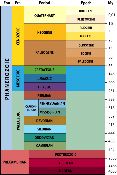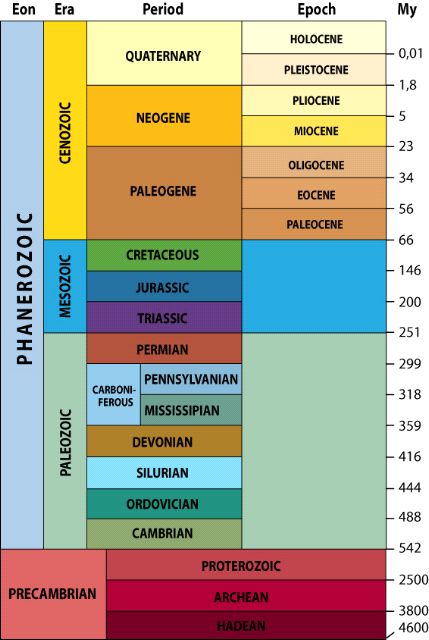The notion of geologic time
At the end of the 18th century, the quest for the age of the Earth propelled the nascent science of geology into a period of rapid development. But the first geologists, mostly European, clashed with religious dogmas, particularly those of Christianity. According to Scripture, the Earth had been created in only six days and had existed for at most a few thousand years...
By observing the slow accumulation of sediments in bodies of water and the time needed to compact them into rock, geologists of the day realized that our planet, with its great thicknesses of sedimentary rocks, must be millions, if not billions of years old. These estimates represent such considerable time spans that the human brain has difficulty comprehending them.
The age of the Earth is estimated at 4.57 billion years.

 (48 kb)Unable to determine the exact ages of rocks and the Earth, British geologists began to classify the different sedimentary layers according to their relative ages. In doing this, they pioneered stratigraphy, a discipline that studies the succession of geologic layers. Stratigraphy is based on a number of principles, of which two are essential: a layer has the same age over its entire spread (the principle of continuity), and in the absence of structural overturning, a layer is always younger than the layers beneath it and older than the layers above it (the principle of superposition).
(48 kb)Unable to determine the exact ages of rocks and the Earth, British geologists began to classify the different sedimentary layers according to their relative ages. In doing this, they pioneered stratigraphy, a discipline that studies the succession of geologic layers. Stratigraphy is based on a number of principles, of which two are essential: a layer has the same age over its entire spread (the principle of continuity), and in the absence of structural overturning, a layer is always younger than the layers beneath it and older than the layers above it (the principle of superposition).
The study of a cliff, for example, allows one to see older sedimentary layers at its base and more recent layers at its summit.
Geologists soon noticed that fossil assemblages were not the same from one stratigraphic layer to another, and thus concluded that they must change over time. For example, the mountainous Jura Massif in Europe contains fossils that correspond to the time during which the encasing sediments were deposited. Wherever we find similar fossils elsewhere, we may suppose that they are the same age and we classify them as Jurassic. Groups of fossils at various stratigraphic levels represent different time periods. By crosschecking between different fossiliferous sites, geologists were able to put these assemblages in relative order and give names to the various time periods. This process produced the geologic timescale, a chronological representation of the Earth’s history, and biostratigraphy, a method of relative dating using fossils contained in the rocks.
Dating became much more precise with the advent of radiometric dating methods in the 1950s. Radiometric dating is based on the “lifespan” of radioactive elements in rocks, and this new approach allowed geologists to pinpoint the age limits between different periods. We know, for example, that the Jurassic began about 200 Ma ago and ended 55 Ma later. Radiometric dating is an “absolute dating” method, meaning that it gives an age in years instead of the “relative dating” offered by fossils, which only indicates only whether a rock is of the same age, older or younger than another rock.
By observing the slow accumulation of sediments in bodies of water and the time needed to compact them into rock, geologists of the day realized that our planet, with its great thicknesses of sedimentary rocks, must be millions, if not billions of years old. These estimates represent such considerable time spans that the human brain has difficulty comprehending them.
Once upon a billion...
- seconds: The first personal computers appeared (1975), signifying the birth of Apple and Microsoft and the beginning of the Information Age.
- minutes: John completed his gospel.
- hours: Neanderthals buried their dead in the Near East.
- days: In Africa, Homo habilis began to fabricate better tools than those of Australopithecus.
- months: The last of the great dinosaurs reigned on Earth.
- years: Life consisted of bacteria, primitive multicellular plants and algae.
The age of the Earth is estimated at 4.57 billion years.

 (48 kb)Unable to determine the exact ages of rocks and the Earth, British geologists began to classify the different sedimentary layers according to their relative ages. In doing this, they pioneered stratigraphy, a discipline that studies the succession of geologic layers. Stratigraphy is based on a number of principles, of which two are essential: a layer has the same age over its entire spread (the principle of continuity), and in the absence of structural overturning, a layer is always younger than the layers beneath it and older than the layers above it (the principle of superposition).
(48 kb)Unable to determine the exact ages of rocks and the Earth, British geologists began to classify the different sedimentary layers according to their relative ages. In doing this, they pioneered stratigraphy, a discipline that studies the succession of geologic layers. Stratigraphy is based on a number of principles, of which two are essential: a layer has the same age over its entire spread (the principle of continuity), and in the absence of structural overturning, a layer is always younger than the layers beneath it and older than the layers above it (the principle of superposition). The study of a cliff, for example, allows one to see older sedimentary layers at its base and more recent layers at its summit.
Geologists soon noticed that fossil assemblages were not the same from one stratigraphic layer to another, and thus concluded that they must change over time. For example, the mountainous Jura Massif in Europe contains fossils that correspond to the time during which the encasing sediments were deposited. Wherever we find similar fossils elsewhere, we may suppose that they are the same age and we classify them as Jurassic. Groups of fossils at various stratigraphic levels represent different time periods. By crosschecking between different fossiliferous sites, geologists were able to put these assemblages in relative order and give names to the various time periods. This process produced the geologic timescale, a chronological representation of the Earth’s history, and biostratigraphy, a method of relative dating using fossils contained in the rocks.
Dating became much more precise with the advent of radiometric dating methods in the 1950s. Radiometric dating is based on the “lifespan” of radioactive elements in rocks, and this new approach allowed geologists to pinpoint the age limits between different periods. We know, for example, that the Jurassic began about 200 Ma ago and ended 55 Ma later. Radiometric dating is an “absolute dating” method, meaning that it gives an age in years instead of the “relative dating” offered by fossils, which only indicates only whether a rock is of the same age, older or younger than another rock.
The stages in fossilization
![]() Open this page with video (4,5mo)
Open this page with video (4,5mo)
Note : For best viewing of this site, you will need this plugins: QuickTimeDownload QuickTime
Description
An Eusthenopteron dies and sinks to the bottom of the ancient Miguasha estuary. He is then covered in layers of sediment that are compressed and hardened over time. Under the effect of erosion the now fossilized fish may reappear at the surface.
These are the stages in fossilization.
Site map | Feedback | Links | Sources | Credits
The notion of geologic time
<< Records of past life | The history of the Devonian System >>



